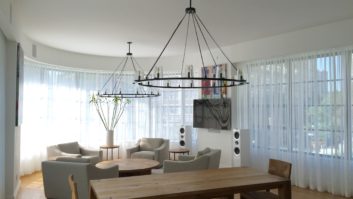You go to a movie theater, get your overpriced popcorn, sit in your seat, and then someone hands you a volume control. Wait, what? No. More likely, the movie comes on and flattens you, leaving you wondering who does set the volume. Let’s investigate and see how you can better specify a sound system that matches your clients’ preferences and budget!
There is actually an international standard for movie volume called reference level (not to be confused with reference grade, which is a somewhat ill-defined term for a system that performs really well). It ensures that movies are at the same volume in your local theater as in the dubbing stage where they were mixed. Without getting overly technical, reference level correlates a signal level on a mixing console’s meters with a specific SPL from a speaker or group of speakers. For the geekier crowd, 20 dB below clip is 85 dB SPL for each LCR, 85 dB for the surround channels combined, and 95 dB for the subwoofers.
If you do the math, that’s a theoretical total peak SPL around 115–120 dB. Won’t that damage your hearing? Yes and no. If you’re a mix engineer who is exposed to that level every day, then you might be concerned. If you go to a movie once a week, you’re probably okay. Movies rarely hit peak level and, even then, only for a few seconds. To my knowledge, there’s never been a study linking an occasional movie to hearing loss, but you should absolutely use your own discretion.
Also by Anthony Grimani: A Fresh Perspective on Tuning Reverberant Rooms
Movie theaters are technically supposed to play at reference level all the time, but they don’t because people complain that it’s too loud. Whether it is or not is debatable; the takeaway is that, if you were to somehow force your clients to listen to reference level at home, you’d have some unhappy clients. But you can use the knowledge to your advantage in specifying the system capability to the nearest dB!
Here’s what I suggest: Specify and calibrate your demo room to the reference level volume scale. (CEDIA recommended practices will tell you how to do this.) Then invite potential clients in and give them the volume control. Look at the level they set during the demo. That will tell you the offset from reference level for this particular client. A properly calibrated processor will read “0 dB” for reference level, so if your client ends up at –10 dB, that is 10 dB below reference level. You can specify a substantially less powerful and less expensive system and they’ll be happy — happier even. And now you can use the available budget elsewhere in the project.
Also by Anthony Grimani: The Phantom of the Home Theater
A few tips on how to implement this.
- Give yourself a little headroom above the client’s chosen level. You never want a system to be running up against its limit.
- You choose the demo material. Film tracks can have significant differences in mix level and dynamic range. Disney, for example, is notorious among enthusiasts for releasing soft and dynamically flat home video mixes over the last decade (including Marvel and Star Wars titles). If you use these for demo, you could get a false sense of how loud the client likes to listen and end up over-powering the sound system.
- Disable DialNorm and any other form of volume leveling and dynamic compression during the demo. Dolby’s position on allowing DialNorm to be disabled seems to have evolved over time, so not every processor will do it. Choose one that will.
- Don’t trust the internal noise in your processor when calibrating levels. Use a verified external source like a test disc (Gold Line TK51 or Dolby’s Atmos Demo and test BDs).
- Spectral balance and decay time affect the perception of volume, so you need to make the client’s environment as similar to your demo room as possible. You must use EQ to smooth out differences in the spectral balance.
- Some people advocate lower volume for home theaters because they have closer speakers and smaller screens (e.g., a TV) than movie theaters. Based on my extensive experience calibrating and listening to both movie theaters and home theaters, I don’t subscribe to this position. Reference level sounds the same everywhere, assuming proper equalization and level calibration. If reference level is too loud for a client in a movie theater, it’s going to be the same amount too loud in a home theater.
- When you listen significantly (10 dB) below reference level, mixes don’t sound the same. Low-level detail — especially in the surround/overhead — gets lost in the background clutter, dialog is harder to understand, and bass sounds are lean. Based on published interviews, mix engineers are aware of this and try to balance tracks for home video accordingly — but this is done somewhat inconsistently because it’s still a relatively new thing. I highly recommend that you make some of your own calibration tweaks when you know a client will be listening below reference. Boost up the surround and bass a little, and maybe considering some “clarity” EQ for the Center.
- Make sure your client’s control system has a clearly marked level that is the “reference level” for that client so they at least have a starting point for where to set the volume.
Anthony Grimani ([email protected]) is president of Grimani Systems, PMI Engineering, and Dimension4 Acoustics, with offices in San Francisco, Los Angeles, and Paris. Chase Walton ([email protected]) contributed to this article.





